Growing cucumbers in greenhouse! Cucumbers are really cool vegetables that you can use in salads, sandwiches, or eat by themselves. When you grow cucumbers in a greenhouse, you can get a lot of them, and they can grow bigger and faster than outside.
A greenhouse keeps them warm and safe from too much rain or bugs. Plus, you can grow cucumbers any time of the year in a greenhouse, even when it’s cold outside! So, let’s learn together how to make your cucumbers happy and healthy in a greenhouse!
Different cucumber varieties were suitable for Growing Cucumbers in Greenhouse
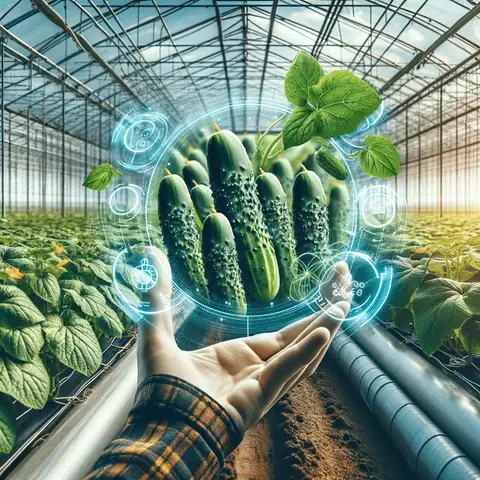
Growing cucumbers in greenhouse offers the chance to try out different varieties. Here’s a look at some popular types:
- Slicing Cucumbers: These are the ones you often see in stores, perfect for salads. Varieties like ‘Marketmore’ and ‘Straight Eight’ are great choices.
- Picklng Cucumbers: Smaller and bumpier, these are ideal for pickling. ‘Boston Pickling’ and ‘National Pickling’ are common choices.
- European Cucumbers: Also known as “English” or “seedless cucumbers,” these are long and thin. Varieties like ‘Telegraph’ are often grown in greenhouses.
- Mini Cucumbers: These are fun and easy to snack on. ‘Miniature White’ is a unique, small variety.
Tips on selecting the best type for your specific needs.
When selecting the best cucumber variety for your greenhouse, consider these tips:
- Space: How much room do you have? Some cucumbers need more space to spread out.
- Purpose: Are you growing cucumbers for salads, snacks, or pickling? Choose a variety that fits your needs.
- Climate Control: Can you control temperature and humidity in your greenhouse? Some varieties might need more specific conditions.
- Taste and Texture: Do you prefer crunchy, sweet, or mild cucumbers? Each variety has its unique flavor and texture.
Importance of climate control in a greenhouse
Climate control in a greenhouse is really important. It helps keep the temperature and humidity just right for plants like cucumbers.
If it’s too hot or too cold, or too wet or dry, the cucumbers might not grow well.
Setting up the right soil and container system.
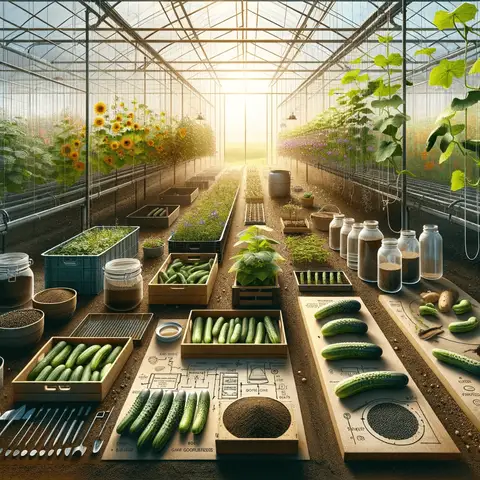
Setting up the right soil and containers is key for growing cucumbers in greenhouse. Here’s what to focus on:
- Choose Good Soil: Cucumbers need soil that drains well but keeps enough moisture. You can mix your own or buy a good vegetable potting mix.
- Picking Containers: Use pots or grow bags that give cucumbers enough room to grow. Make sure they have holes at the bottom for drainage.
With the right soil and containers, your cucumbers will have a great start in your greenhouse!
Planting cucumber seeds
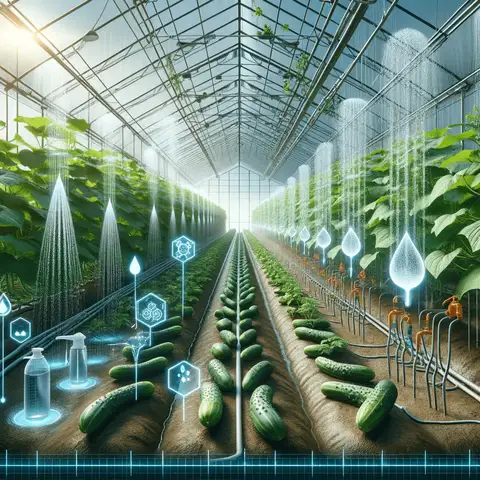
Here’s a simple guide to planting cucumber seeds in your greenhouse:
- Get Your Seeds Ready: Choose the cucumber variety you want to grow.
- Prepare Soil and Containers: Fill pots or grow bags with good-quality, well-draining soil.
- Plant the Seeds: Make small holes in the soil (about half an inch deep) and place one or two seeds in each.
- Cover the Seeds: Gently cover the seeds with soil.
- Water Carefully: Water the soil to keep it moist, but be careful not to overwater.
- Provide Warmth: Keep the soil warm, around 70°F, which is perfect for cucumber seeds to germinate.
- Wait for Sprouts: In about a week, you should see little plants popping up.
- Give Them Light: Once they sprout, make sure they get enough light.
- Thin the Plants: If you planted two seeds per hole, remove the weaker seedlings.
Spacing and depth for optimal growth.
When planting cucumbers in a greenhouse, spacing, and depth is crucial for their best growth:
- Depth: Plant cucumber seeds about half an inch to an inch deep in the soil.
- Spacing in Rows: If you’re planting in rows, keep about 18 to 36 inches between each plant. This gives each cucumber plant enough room to grow.
- Spacing Between Rows: Leave about 4 to 6 feet between rows. This allows you to walk between rows and gives plants space to spread out.
Getting the depth and spacing right helps cucumbers grow strong and healthy!
Best practices for watering cucumbers in a greenhouse.
For watering cucumbers in a greenhouse, here are some best practices:
- Consistent Watering: Keep the soil evenly moist but not soggy.
- Morning Watering: Water early in the day so excess moisture can evaporate.
- Check Soil Moisture: Before watering, check if the top inch of soil is dry.
- Avoid Overwatering: Too much water can lead to root rot.
- Water at the Base: Direct water to the soil to avoid wetting the leaves, which can cause diseases.
Proper watering ensures healthy growth and helps prevent common issues in cucumbers.
Maintaining the right humidity level
Maintaining the right humidity level in a greenhouse is important for cucumbers. Here’s what to do:
- Ideal Humidity: Aim for 50-70% humidity for cucumbers.
- Use a Hygrometer: This tool helps you check the humidity level.
- Ventilation: Open vents or use fans to reduce high humidity.
- Water Management: Proper watering affects humidity, so water the plants correctly.
- Misting Systems: In dry conditions, a misting system can help increase humidity.
Keeping the humidity just right helps cucumbers grow healthy and strong!
Light and Temperature Requirements
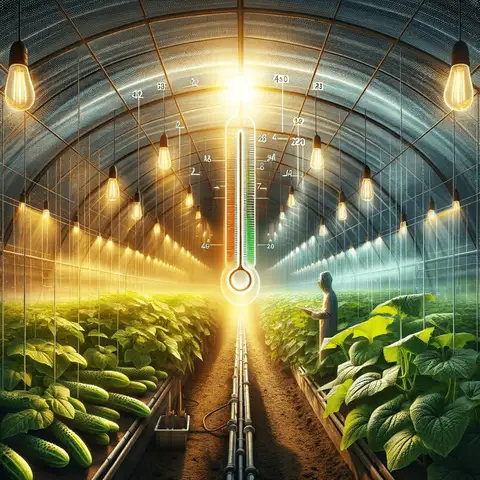
Cucumbers in a greenhouse need the right light and temperature:
- Light Needs: Cucumbers need lots of light, about 14-16 hours a day. Make sure they get enough natural or artificial light.
- Temperature for Seedlings: Keep it warm, around 70-75°F, for seeds to sprout.
- Growing Temperature: Once they grow, 65-75°F during the day and 60-65°F at night is ideal.
- Avoid Cold: Cucumbers don’t like cold. Keep them away from chilly drafts.
Getting light and temperature right helps cucumbers grow big and healthy.
Essential nutrients and their role in cucumber growth.
Cucumbers need certain nutrients to grow well:
- Nitrogen: Helps leaves grow. It’s important early on.
- Phosphorus: Good for roots and flowers.
- Potassium: This keeps the plant healthy overall.
- Calcium: Helps prevent blossom end rot.
- Magnesium: Part of chlorophyll is needed for photosynthesis.
Each nutrient plays a special part in helping cucumbers grow big and tasty.
Soil preparation and fertilization for cucumbers
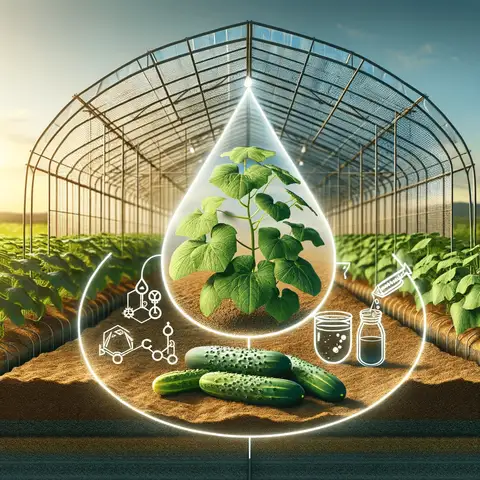
Preparing soil and fertilizing correctly is key for growing cucumbers:
- Soil Preparation: Use soil that drains well but holds moisture. Add compost or aged manure to enrich it.
- Fertilization: Start with a balanced fertilizer. When cucumbers begin to flower, switch to a fertilizer with more potassium and phosphorus to support fruit growth.
This helps cucumbers grow healthy and strong.
Pest and Disease Management
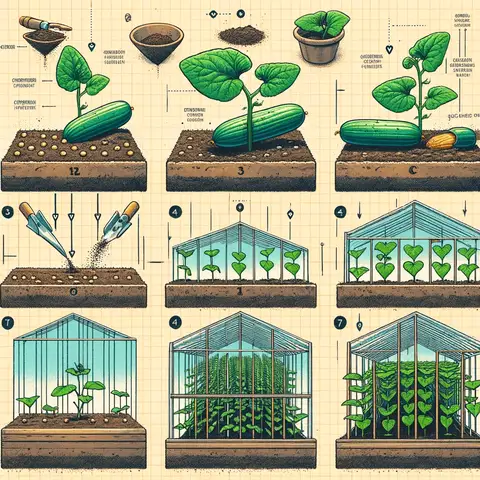
Pest and disease management is key for healthy greenhouse cucumbers. Here’s a guide to help you keep your cucumbers thriving!
Pests in Greenhouse Cucumbers
- Spider Mites: Tiny bugs that make leaves have yellow spots.
- Aphids: Little green bugs that suck juice from plants.
- Whiteflies: Tiny white bugs that fly and eat leaves from below.
- Thrips: Small bugs that make leaves look silvery.
Diseases in Greenhouse Cucumbers
- Powdery Mildew: Leaves get white, powdery spots.
- Downy Mildew: Leaves turn yellow with purple stuff underneath.
- Gray Mold (Botrytis): Leaves get gray-brown spots when it’s wet.
- Root Rot: The roots get sick if the plant drinks too much water.
Ways to Stop Pests and Diseases Without Chemicals
- Neem Oil: A special oil that stops many bugs and mildew.
- Soap for Bugs: A safe soap that keeps bugs away.
- Friendly Bugs: Like ladybugs, they eat the bad bugs.
- Good Air: Keep the air moving to stop mold and mildew.
Ways to Stop Pests and Diseases With Chemicals
- Acaricides: Medicine for plants to stop spider mites.
- Insecticides: Strong bug spray. Use it carefully!
- Fungicides: Spray to keep the plant safe from mold.
- Soil Fumigants: For very sick roots. Be very careful with this!
Check your plants often. Use the right mix of safe and strong ways to keep your cucumbers happy and healthy! ????✨????
Pollination in Cucumber Growth
Pollination is like a plant’s way of having babies. It’s super important for cucumbers to grow. Flowers need pollen from other cucumber flowers to make cucumbers. In greenhouses, we sometimes have to help with this.
How to Pollinate Cucumbers by Hand
Pollination is like helping plants have baby cucumbers
- Finding Flowers: Cucumbers have boy and girl flowers. Boy flowers have the pollen. Girl flowers make cucumbers.
- Using a Brush or Swab: Take a little brush or a cotton swab. Gently get pollen from the boyflower.
- Putting Pollen on Girl Flowers: Now, put the pollen on the middle part of the girl flower.
- Do It Again: Keep doing this with all your cucumber plants. This helps you get lots of cucumbers!
By doing this, you’ll get lots of yummy cucumbers in your greenhouse.
Pollinating Cucumbers in Greenhouses
In greenhouses, there are fewer bees or wind to help with pollination. That’s why hand pollination is so helpful. It makes sure that the flowers get pollen so that they can make cucumbers. Doing it right means more and better cucumbers for you!
Pruning and Training Cucumber Plants
Pruning and training are like giving your cucumbers a good haircut and teaching them where to grow. It helps them grow better and healthier.
How to Prune and Train Cucumbers
Pruning:
- Find the Main Stem: This is the main part of the plant.
- Remove Side Shoots: Cut off little branches (side shoots) that grow from the main stem. Do this when they’re about 4 inches long.
- Leave the Top Alone: Let the top of the plant keep growing.
Training:
- Use Stakes or Strings: Tie the main stem gently to a stake or a string hanging from the top of your greenhouse.
- Guide the Plant Upward: As the plant grows, keep tying it to the stake or string. This helps it grow tall and straight.
Importance of Trellising in Greenhouse Cultivation
Trellising is using things like strings or frames to support your cucumber plants. It’s super important in greenhouses because:
- Saves Space: It helps cucumbers grow up, not out, so you save space.
- Better Air Flow: It keeps the air moving around the plants, which is good for their health.
- Easier Harvesting: When cucumbers grow up a trellis, they’re easier to find and pick.
- Healthier Plants: Keep cucumbers off the ground, away from pests and diseases.
Pruning Greenhouse Cucumbers
Pruning is important in greenhouses because it helps control how the plants grow. It makes sure the cucumbers get enough light and air. It also helps in growing bigger and better cucumbers. Remember always to use clean, sharp tools for pruning!
Harvesting Cucumbers in a Greenhouse
Harvesting is when you get to pick and enjoy your cucumbers!
Signs of Readiness for Harvesting Cucumbers
- Size: Inspect the seed package for the ideal size. Usually, they’re ready when they’re approximately 6 to 8 inches long.
- Color: They should be encouraging, even green. Yellow or pale means they’re overripe.
- Firmness: They should be strong to the touch, not soft or squishy.
- Shiny Skin: Look for a nice, shiny skin. Dull skin can mean they’re too old.
Best Practices for Harvesting
- Use a Knife or Pruners: Cut the stem close to the cucumber. Don’t pull or twist; this can hurt the plant.
- Harvest Often: The more you pick, the more cucumbers your plant will make.
- Morning Harvest: Pick cucumbers in the morning when they’re cool and crisp.
- Gentle Handling: Be gentle to avoid bruising the cucumbers.
Promoting Continuous Yield
- Regular Checks: Check your plants every day or two. Cucumbers can grow fast!
- Even Watering: Keep the soil moist but not too wet. This helps with continuous growth.
- Fertilize: Give your plants some food (fertilizer) to help them keep producing.
- Disease and Pest Control: Keep an eye out for pests or diseases and deal with them quickly.
Growing cucumbers in greenhouse is exciting! By following these tips, you’ll have a steady supply of fresh, tasty cucumbers. Happy harvesting!













